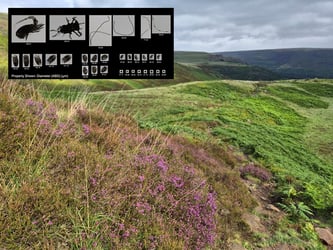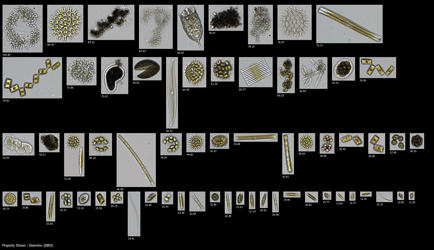Green Noctiluca scintillans, or gNoctiluca, is one of the fastest biogeographically spreading marine planktonic organisms in the world's oceans and has been known to form extensive green tides in tropical coastal ecosystems. What's most notable about the species N. scintillans is that it occupies both heterotrophic as well as mixotrophic niches. FlowCam was used to capture images of the mutualistic partnership it establishes with the prasinophyte green alga Protoeuglena noctiluca. gNoctiluca has been shown to manipulate the growth of its endosymbiont population to exploit its photosynthetic products to meet critical energy needs and stimulate rapid reproduction.
 Pictured here: FlowCam images of gNoctiluca cells with endosymbionts, imaged at 40X
Pictured here: FlowCam images of gNoctiluca cells with endosymbionts, imaged at 40X
This paper highlights gNoctiluca's nutritional and reproductive strategies that facilitate its ability to form intense and expansive blooms, negatively impacting regional water, food, and socio-economic security in several tropical countries.
The process by which nutrients first accumulate in gNoctiluca cells primarily via grazing, and are then released into the ambient environment during the sexual reproduction phase, to be later used by diatoms or dinoflagellates and ultimately back to support the growth of gNoctiluca, constitutes a positive feedback nutrient loop. Accumulation of ammonium may potentially stimulate the initiation of sexual reproduction of gNoctiluca, contributing to the outbreak of the bloom.

Pictured above: positive nutrient feedback loop as documented by FlowCam
"FlowCam proved so useful in our discovery of the new mode of cell division in gNoctiluca blooms that were studied off the coast of Oman." Dr. Joaquim Goes, principal researcher and co-author of this study. FlowCam provided high-resolution images to illuminate the linkage between the nutritional and reproductive strategies of this organism. The positive nutrient feedback loop associated with the blooms contributes to sexual reproduction as an accelerator for bloom formation.
In these tropical regions, extensive blooms can impact the food chain by resulting in swarms of jellyfish and salps, which replace natural fish stocks. Additionally, blooms create water quality issues that impact freshwater, food, economic security, and the well-being of the populations living in these regions.
Read the paper to learn more about this fascinating mode of reproduction as an essential part of bloom formation.











